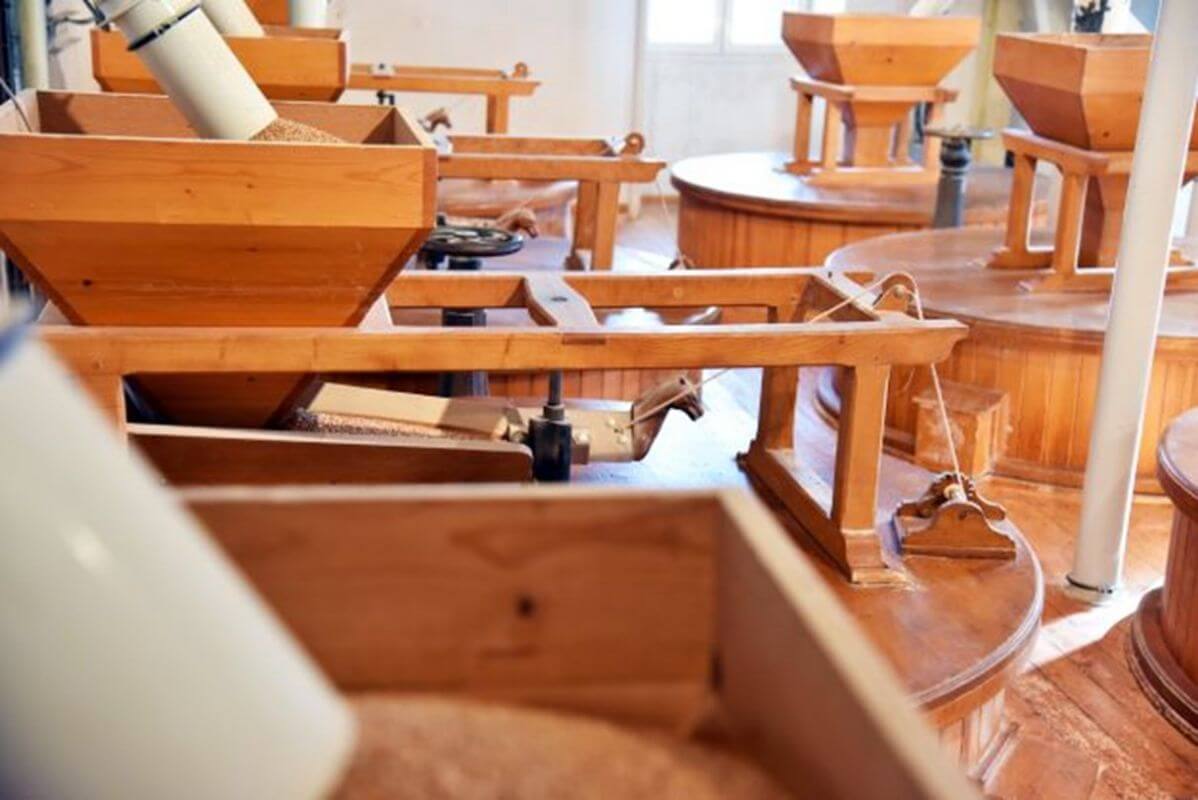Stone-ground flours are much richer in nutrients than cylinder-milled flours. They also contain more fibre. These flours have certain characteristics that influence bread-making.
Stone-ground flours are part of our milling history. The development of this milling technique was motivated by a number of factors, from the philosophy behind the process to the improved qualities. These are qualities that you pass on to your customers when you bake your bread. A closer look at the advantages of stone-milled flours.
Stone-milled flours perpetuate a traditional method with a short process
The production of stone-milled flours dates back to prehistoric times. The principle is simple: the grain passes between two stones rotating on top of each other. The one below is fixed. It is called the “dormant” stone, as opposed to the one above which is moving. Although man has been crushing grain since the Palaeolithic era, the first mills were built in the 5th century BCE. They were operated manually. Technology, of course, improved over the centuries. Starting with mechanisation to make the millstones turn using first water, then air and then electricity. The millstones were also refined and grooves were cut into them. They were designed to make it easier for the grain to pass through, reduce heating and improve the grinding process. The distance between the millstones could be adjusted.
Stone-milled flours were the norm until the 19th century. At this point, cylinder-milling for soft wheat first appeared. This process was gradual and involved more stages. With the industrial revolution, technology spread until it became the standard on the flour market. As millers, we wanted to perpetuate and develop the ancestral millstone method. And we have done so since the late 1980s. Not out of nostalgia, but because flours produced using millstones offer real benefits in terms of nutrition and flavour. History proves us right, as more and more consumers aspire to the most raw food possible.
Stone-ground flours are high in fibre
Flours milled with millstones are high in fibre. With this production method, most of the grain ends up in the milling process. The fractions derived from the kernel make up the bulk of the flour obtained. But it also contains elements from the outside of the wheat. These parts, which correspond to the husks of the wheat, are rich in cellulose, a type of insoluble fibre. Flour produced using millstones meets part of the requirements of the French National Health and Nutrition Plan (PNNS). Public health authorities recommend increasing our fibre intake. Fibre regulates food intake and digestion.
Stone-ground flours contain fine parts of grain husks. They are an even creamy beige colour. This is because the flour is made up of different fractions of fairly similar sizes. The grain size is generally finer than with a conventional milled flour. A cylinder milling process, on the other hand, seeks to extract the peripheral parts of the grains, which are rich in fibre. You can then reintegrate the brands and regrinds to make wholemeal or wholemeal flour. But because the particle sizes are very different in this case, the miller obtains a mixture of white flour with dark bits, unlike stone-ground flours.
Good nutritional density of ground flou
Another major advantage of stone-ground flours is that they contain more micronutrients. And with good reason: once again, it is in the outermost parts of the grain that the minerals and vitamins are concentrated. They are mainly present in the husks (13-16% of the grain) and in the wheat germ (2 to 3%). This is preserved in the stone-ground flours. In a conventional process, however, it is separated by passing the wheat through a number of cylinders. The husks are rich in minerals, and the germ in vitamins B and E. All these elements, useful to our metabolism, are therefore present in their entirety in a stone-milled flours. Wheat germ also contains vitamin B1: thiamine. The body is not capable of synthesising it. It must therefore be provided in our diet.
With an equivalent extraction rate of 80%, “grinding on millstones significantly increases magnesium and zinc content” by around 30%, according to tests carried out in the laboratory (Industries des Céréales no. 142).
Large, lovely coloured breads with stone-milled flour
In the bakery, the characteristics of the stone-milled flours have an impact on the bread-making process. The forces exerted by the stones tend to damage the starch granules. As a result, the flour has a greater capacity to absorb water. The presence of fibres also explains this phenomenon. The dough then runs the risk of becoming excessively sticky and slack. Furthermore, the ratio of gliadin-type proteins to glutenin-type proteins is relatively higher in stone-milled flours. This makes it easier to stretch the dough when shaping. It is in fact more stretchy.
The enzymes naturally present in flour can access the starch more easily. They break down these complex molecules into glucose. Its greater availability facilitates fermentation and potentially increases volume. The increased presence of simpler sugars also encourages Maillard reactions during cooking. The crusts of bread made with stone-milled flour are more coppery. To compensate for the gluten’s fragility at the start of fermentation, we recommend a pre-fermentation stage. Our consultant bakers can help you master starters and sourdoughs. Stone-ground flour lends itself well to bread-making. The flavour of the bread will be all the richer for it.
The nutritional value of stone-milled flours means that bread products can be enriched naturally. A bonus for the increasingly health-conscious consumer. Our mill works with several types of organic cereals. To take care of our food and the environment.

